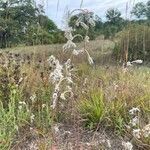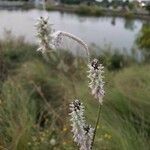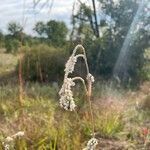Plants annual; taproots semi-woody. Stems 1, erect or ascend-ing, sometimes procumbent, simple or sparsely branched (rarely much-branched) from base or above, stout, to 18 dm, puberulent or tomentulose with short, viscid, whitish or brownish hairs. Leaves principally on proximal 1/3 of plant, petiolate; blade lanceolate to oblanceolate, oblong, or linear, largest leaves 3.8-11.2(-21) × 0.5-3.8(-4.2) cm, base attenuate to cuneate, apex acute to obtuse, canescent to subscabrous adaxially, sericeous-tomentose abaxially. Spikes dense, much-branched, apex often pyramidal, flowers arranged in 5-ranked spiral; bracteoles stramineous or blackish, pubescent with small tufts distally. Flowers 4-6 mm; perianth lobes, greenish white to pinkish, oblong, apex acute; filament lobes slightly to greatly recurved distally, stramineous to pinkish, apex acute. Utricles flask-shaped, 5 × 4-5 mm, with irregularly dentate lateral wings, both surfaces of perianth with distinct spines or tubercles. 2n = 58 + 2.



